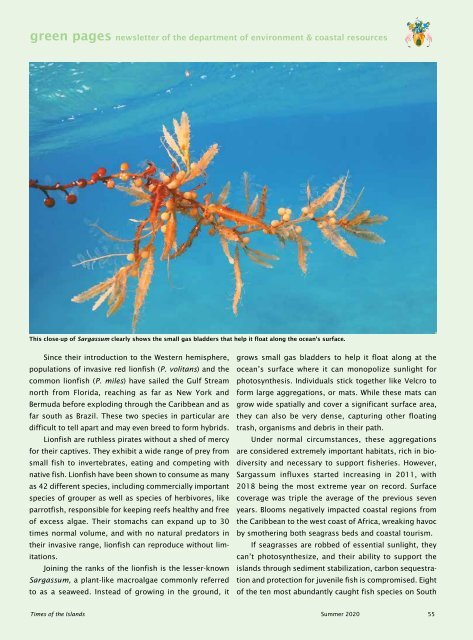Times of the Islands Summer 2020
Presents the "soul of the Turks & Caicos Islands" with in-depth features about local people, culture, history, environment, businesses, resorts, restaurants and activities.
Presents the "soul of the Turks & Caicos Islands" with in-depth features about local people, culture, history, environment, businesses, resorts, restaurants and activities.
You also want an ePaper? Increase the reach of your titles
YUMPU automatically turns print PDFs into web optimized ePapers that Google loves.
green pages newsletter <strong>of</strong> <strong>the</strong> department <strong>of</strong> environment & coastal resources<br />
This close-up <strong>of</strong> Sargassum clearly shows <strong>the</strong> small gas bladders that help it float along <strong>the</strong> ocean’s surface.<br />
Since <strong>the</strong>ir introduction to <strong>the</strong> Western hemisphere,<br />
populations <strong>of</strong> invasive red lionfish (P. volitans) and <strong>the</strong><br />
common lionfish (P. miles) have sailed <strong>the</strong> Gulf Stream<br />
north from Florida, reaching as far as New York and<br />
Bermuda before exploding through <strong>the</strong> Caribbean and as<br />
far south as Brazil. These two species in particular are<br />
difficult to tell apart and may even breed to form hybrids.<br />
Lionfish are ruthless pirates without a shed <strong>of</strong> mercy<br />
for <strong>the</strong>ir captives. They exhibit a wide range <strong>of</strong> prey from<br />
small fish to invertebrates, eating and competing with<br />
native fish. Lionfish have been shown to consume as many<br />
as 42 different species, including commercially important<br />
species <strong>of</strong> grouper as well as species <strong>of</strong> herbivores, like<br />
parrotfish, responsible for keeping reefs healthy and free<br />
<strong>of</strong> excess algae. Their stomachs can expand up to 30<br />
times normal volume, and with no natural predators in<br />
<strong>the</strong>ir invasive range, lionfish can reproduce without limitations.<br />
Joining <strong>the</strong> ranks <strong>of</strong> <strong>the</strong> lionfish is <strong>the</strong> lesser-known<br />
Sargassum, a plant-like macroalgae commonly referred<br />
to as a seaweed. Instead <strong>of</strong> growing in <strong>the</strong> ground, it<br />
grows small gas bladders to help it float along at <strong>the</strong><br />
ocean’s surface where it can monopolize sunlight for<br />
photosyn<strong>the</strong>sis. Individuals stick toge<strong>the</strong>r like Velcro to<br />
form large aggregations, or mats. While <strong>the</strong>se mats can<br />
grow wide spatially and cover a significant surface area,<br />
<strong>the</strong>y can also be very dense, capturing o<strong>the</strong>r floating<br />
trash, organisms and debris in <strong>the</strong>ir path.<br />
Under normal circumstances, <strong>the</strong>se aggregations<br />
are considered extremely important habitats, rich in biodiversity<br />
and necessary to support fisheries. However,<br />
Sargassum influxes started increasing in 2011, with<br />
2018 being <strong>the</strong> most extreme year on record. Surface<br />
coverage was triple <strong>the</strong> average <strong>of</strong> <strong>the</strong> previous seven<br />
years. Blooms negatively impacted coastal regions from<br />
<strong>the</strong> Caribbean to <strong>the</strong> west coast <strong>of</strong> Africa, wreaking havoc<br />
by smo<strong>the</strong>ring both seagrass beds and coastal tourism.<br />
If seagrasses are robbed <strong>of</strong> essential sunlight, <strong>the</strong>y<br />
can’t photosyn<strong>the</strong>size, and <strong>the</strong>ir ability to support <strong>the</strong><br />
islands through sediment stabilization, carbon sequestration<br />
and protection for juvenile fish is compromised. Eight<br />
<strong>of</strong> <strong>the</strong> ten most abundantly caught fish species on South<br />
<strong>Times</strong> <strong>of</strong> <strong>the</strong> <strong>Islands</strong> <strong>Summer</strong> <strong>2020</strong> 55

















